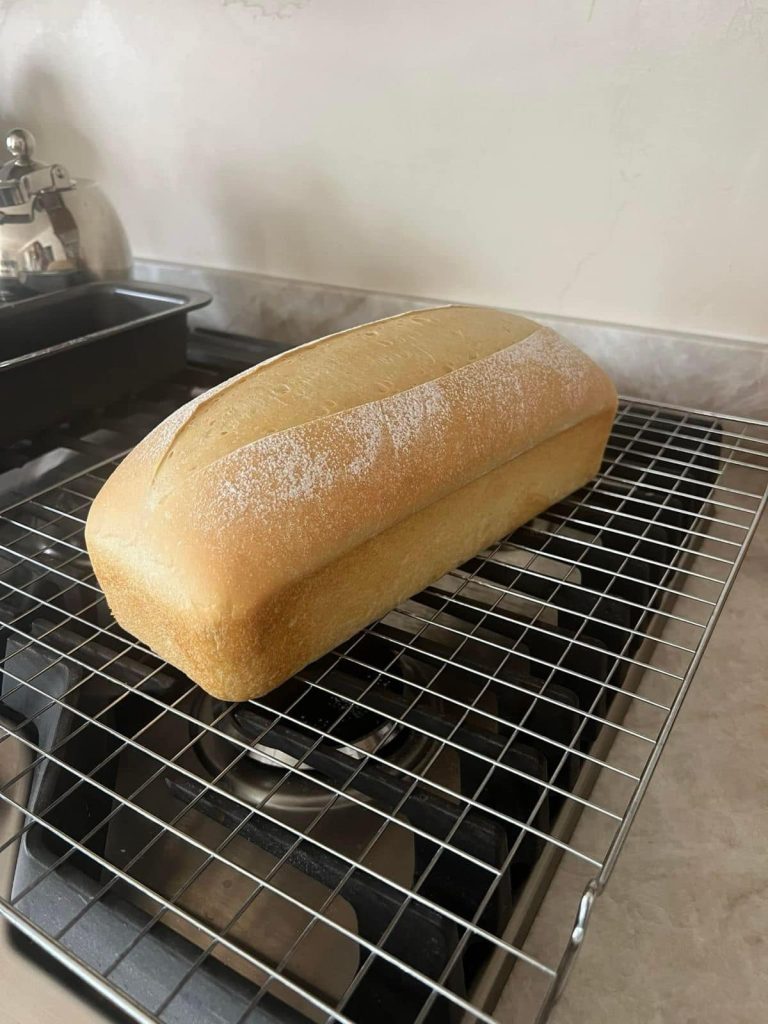Here’s a straightforward recipe for crafting your own homemade sourdough sandwich bread, requiring just a few basic ingredients. I prefer to prepare the dough in the evening to enjoy fresh bread in the morning. This loaf also freezes well, either whole or sliced. I highly recommend using an 8.5×4 inch loaf pan for optimal results.
Ingredients
- 500 g (4 cups) all-purpose flour
- 60 g (4 tbsp.) softened, unsalted butter (cut into cubes)
- 12 g (1 tbsp.) sugar
- 9 g fine sea salt
- 50 g (1/4 cup) of bubbly, fully hydrated sourdough starter
- 270 g (1 cup + 2 tbsp) warm water
Helpful Tips:
If the weather is cooler, the second rise might take longer than anticipated. To expedite this process, you can utilize an 8.5×4 inch loaf pan, adjust the amount of starter, and tweak the water quantity for optimal results. Choose one of the following adjustments while keeping the other ingredient quantities constant:
- 100 g starter + 255 g water
- 150 g starter + 250 g water
Moreover, since temperature affects rise time, you can increase the surrounding temperature during the bulk or second rise as needed. You can use a proofing box set to 75-80 F or preheat your home oven to 75-80 F and then switch it off immediately (ensure it’s precisely 80 F with an oven thermometer). Put the dough inside the cover and let it solidify. Avoid using this option overnight as it might become too warm.
Instructions
Baking Schedule: This recipe involves an overnight process, typically taking around 10-12 hours to rise at 68 F. Commence preparation the night before and plan to bake the following day. If the temperature exceeds 68 F, the dough will rise more swiftly. Alternatively, you can begin in the morning and bake in the afternoon or evening.
Mix the Dough
Using a stand mixer fitted with the paddle attachment, combine flour, butter, sugar, and salt on low speed until thoroughly mixed; the butter should resemble crumbs.
Add the starter and warm water. Till the flour is all absorbed, keep mixing.The dough will possess a slightly sticky and elastic consistency at this stage. After covering with plastic wrap or a moist cloth, allow it to rest for half an hour. Meanwhile, refresh your starter with fresh flour and water.
After the resting period, switch to the dough hook and knead the dough on medium-low speed (#3 on a KitchenAid) for 6-8 minutes. The dough should feel soft, supple, and not stick to your hands. If it does, lightly dust with flour.
Note: If you lack a stand mixer, the dough can be prepared by hand. After mixing and resting for 30 minutes, knead the dough on a lightly floured surface for 8-10 minutes until it becomes smooth, soft, and elastic. Don’t fret over under or over-kneading; focus on achieving the desired texture rather than adhering strictly to timing.
Bulk Rise
The dough will rise overnight at room temperature (68 F) if the bowl is covered with plastic wrap. This should take around 10 to 12 hours. Refer to the Baking Schedule above for alternative rise time options.
Shape the Dough
- In the morning, grease an 8.5×4 inch loaf pan with butter.
- Transfer the dough onto a lightly floured surface. Gently flatten to release any large air bubbles.
- Tuck the ends under as you roll the dough into a log. Allow it to rest for 5-10 minutes. With floured hands, gently cup the dough and pull it towards you to tighten its shape. Using a bench knife, place the dough into the loaf pan with the seam side facing downwards.

Second Rise
1-Wrap the dough in plastic wrap that has been buttered or gently oiled. Let it rest at room temperature until it rises to about 1 inch above the rim of the pan (observe the height by examining the domed center portion of the dough).
2-It’s not necessary for it to double in size. Depending on temperature and the amount of sourdough starter used, this can take anywhere from 1 1/2-2 hours or more. Remember, warmer temperatures facilitate faster rise. Consult the “Helpful Tips” section at the beginning of this post for guidance.
Bake the Dough
1-Preheat your oven to 375 F. For enhanced oven spring, preheat to 500 F instead, then reduce to 375 F once the dough is placed in the oven. Bake on the center rack for about 45-50 minutes until golden brown.
2-Allow the bread to cool in the pan for at least 10 minutes before transferring it to a rack to cool completely.
3-This sandwich loaf remains fresh for up to 3 days when stored in a plastic bag at room temperature.
Notes
1.For precise results, it’s advisable to weigh your ingredients using a scale rather than relying on measuring cups. Weight and volume measurements are not equivalent, leading to potential discrepancies in the final product.
2.This is especially critical concerning the sourdough starter; if it’s excessively bubbly, 1/4 cup might only weigh 30 g, which is insufficient for this recipe, resulting in a prolonged rise time.
3.The same principle applies to flour; 4 cups may weigh substantially more than 500 g depending on how tightly packed it is. This could yield a drier dough.
4.I utilized Whole Foods 365 Everyday all-purpose flour for this recipe, although King Arthur and Trader Joe’s all-purpose flour are also suitable choices. If you choose a different brand (Gold Medal, Pillsbury, Heckers) that has less protein, you might want to cut back on the total water content by 15g.
